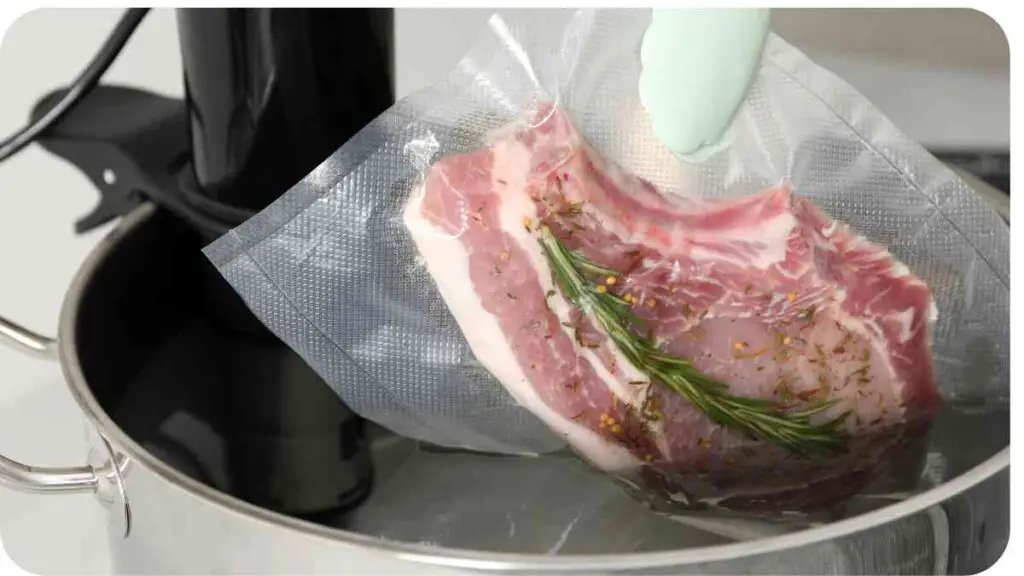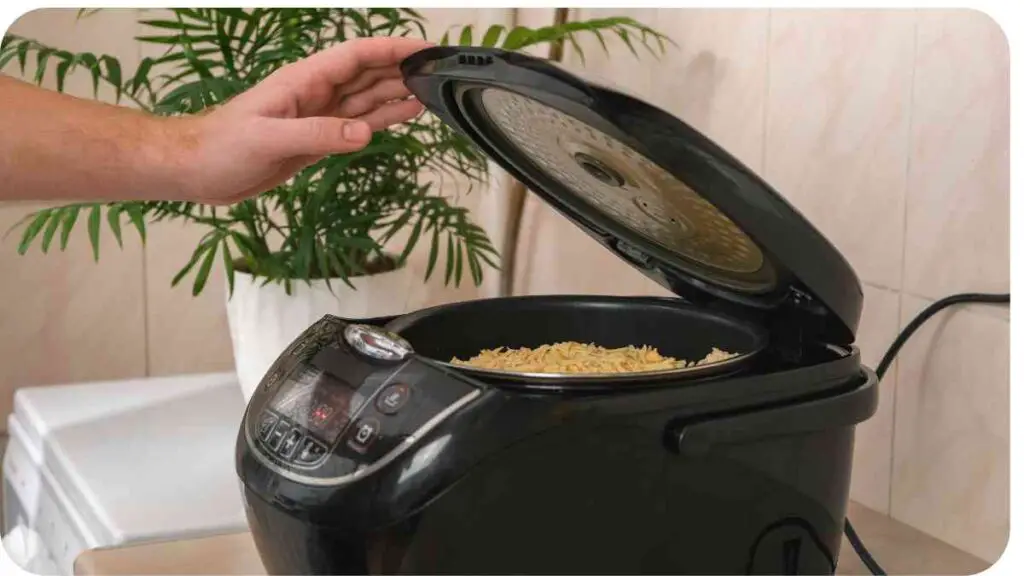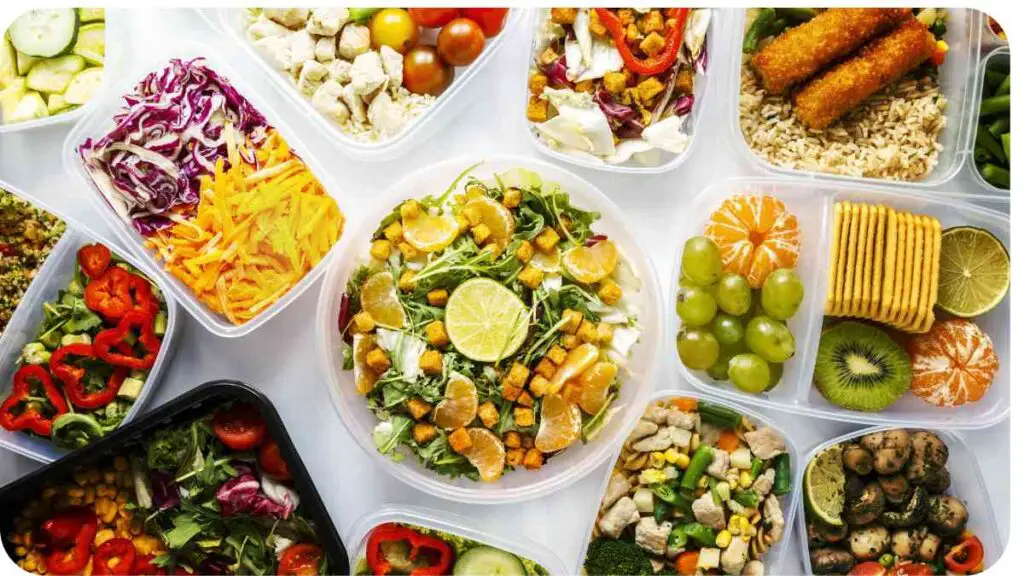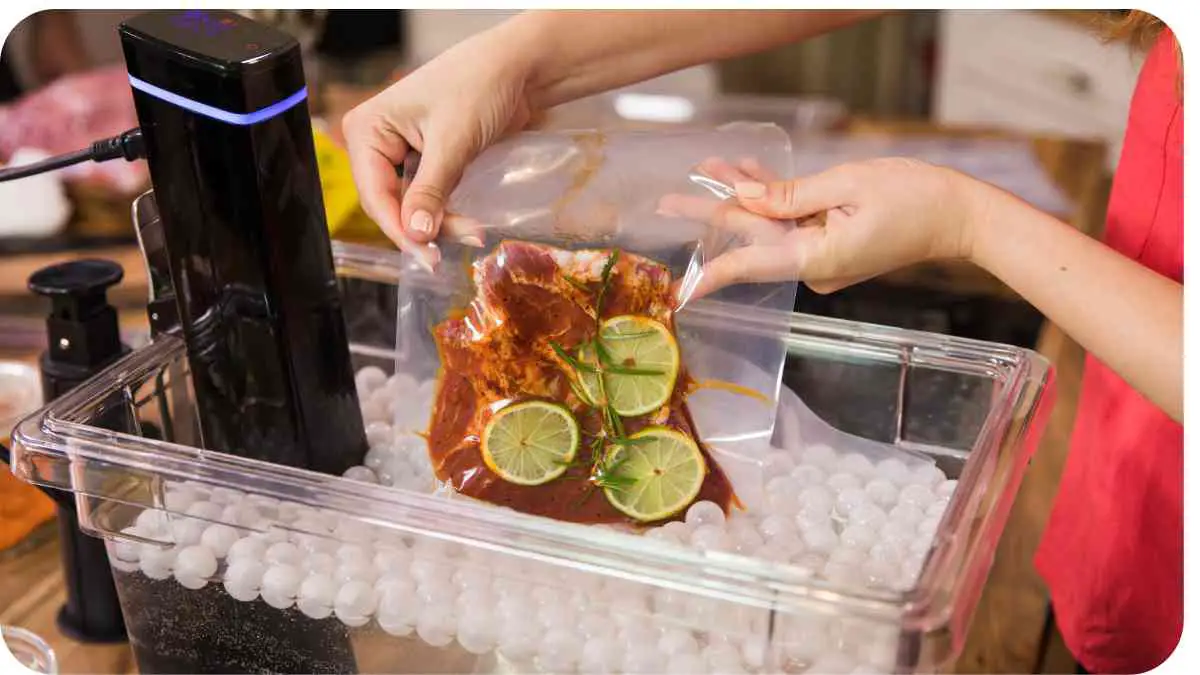Welcome to the world of Sous Vide cooking! In this comprehensive guide, we’ll explore the ins and outs of this revolutionary cooking method, from its unique benefits to practical tips for achieving perfection in every bite.
Whether you’re a seasoned chef or a home cook looking to elevate your culinary skills, Sous Vide has something to offer.
| Takeaways |
|---|
| Sous Vide offers precise temperature control for consistent results. |
| Enhance flavors and textures with Sous Vide cooking, not just for meats. |
| Essential equipment includes a precision cooker, vacuum sealer, and water container. |
| Experiment with various ingredients, seasonings, and marinades for unique dishes. |
| Master the art of preheating, seasoning, and finishing techniques for perfect Sous Vide results. |
| Overcome myths like Sous Vide being complicated or only for meat – it’s versatile and accessible. |
| Learn from Chef profiles and home cook testimonials to inspire your Sous Vide journey. |
| Troubleshoot challenges like overcooking and undercooking with expert tips. |
| Practice sustainable Sous Vide with energy-efficient methods and food waste reduction strategies. |
| Maintain equipment through proper cleaning, storage, and care for long-term success. |
| Explore further reading for in-depth knowledge from reputable sources in the Sous Vide community. |
| Get answers to FAQs, ensuring a comprehensive understanding of Sous Vide cooking. |
2. What is Sous Vide?
Sous Vide, French for “under vacuum,” is a cooking technique that involves sealing food in a vacuum-sealed bag and immersing it in a precisely controlled water bath. This method ensures consistent and precise cooking, resulting in perfectly cooked food with enhanced flavors and textures.
3. Why Sous Vide Cooking is Unique
3.1 Precise Temperature Control
One of the key advantages of Sous Vide is the ability to control cooking temperatures with unparalleled accuracy. This section will delve into the science behind precise temperature control and its impact on the final dish.
| Sous Vide Temperature | Resulting Outcome |
|---|---|
| 130°F (54°C) | Medium-Rare Steak |
| 145°F (63°C) | Perfectly Cooked Salmon |
| 183°F (84°C) | Tender and Juicy Chicken Breast |
3.2 Enhanced Flavors and Textures
Unlike traditional cooking methods, Sous Vide allows for optimal flavor retention and texture preservation. We’ll explore how this technique unlocks the full potential of your ingredients, resulting in a dining experience like no other.
| Ingredient | Sous Vide Result |
|---|---|
| Root Vegetables | Intensified Natural Sweetness |
| Tough Cuts of Meat | Fork-Tender Perfection |
| Delicate Seafood | Moist and Flaky Texture |
3.3 Time and Energy Efficiency
Sous Vide not only produces superior results but is also a time and energy-efficient cooking method. We’ll discuss how Sous Vide can streamline your cooking process and save you valuable resources.
| Cooking Method | Time Efficiency | Energy Consumption |
|---|---|---|
| Traditional Oven | Lengthy Cooking Times | High Energy Usage |
| Sous Vide | Set-and-Forget Convenience | Minimal Energy Consumption |
4. Essential Sous Vide Equipment

4.1 Sous Vide Precision Cooker
To embark on your Sous Vide journey, you’ll need a reliable precision cooker. We’ll explore the top-rated models, their features, and how to choose the one that suits your needs.
| Sous Vide Precision Cooker | Key Features | Price Range |
|---|---|---|
| Anova Precision Cooker | Bluetooth Connectivity, User-Friendly Interface | $100 – $200 |
| Joule Sous Vide | Compact Design, Powerful Heating Element | $150 – $250 |
| ChefSteps Joule | WiFi Connectivity, Precise Temperature Control | $200 – $300 |
4.2 Vacuum Sealer
A proper vacuum sealer is crucial for Sous Vide cooking. We’ll discuss the importance of vacuum sealing and recommend vacuum sealer models with user-friendly features.
| Vacuum Sealer Model | Key Features | Price Range |
|---|---|---|
| FoodSaver FM5200 | Automatic Bag Detection, Built-in Roll Storage | $100 – $150 |
| NutriChef Vacuum Sealer | Compact Design, Starter Kit Included | $50 – $100 |
| Anova Precision Vacuum Sealer | Adjustable Seal Levels, Easy to Clean | $80 – $120 |
4.3 Water Container
Choosing the right water container is essential for maintaining a stable cooking environment. We’ll guide you through the selection process and recommend containers suitable for different kitchen setups.
| Water Container Type | Material | Size | Price Range |
|---|---|---|---|
| Cambro Polycarbonate Container | Polycarbonate | 12 Quarts | $20 – $30 |
| Rubbermaid Commercial Container | Polypropylene | 18 Quarts | $15 – $25 |
| Lipavi Sous Vide Container | Polycarbonate | 26 Quarts | $30 – $40 |
5. Choosing the Right Ingredients
5.1 Meats
Selecting the right cuts of meat is crucial for Sous Vide success. We’ll provide a guide to choosing meats, including recommended cooking temperatures and times.
| Meat Type | Recommended Temperature | Sous Vide Time Range |
|---|---|---|
| Filet Mignon | 130°F (54°C) | 1.5 – 4 hours |
| Chicken Breast | 140°F (60°C) | 1 – 4 hours |
| Salmon Fillet | 125°F (52°C) | 30 minutes – 1 hour |
5.2 Vegetables
Sous Vide is not just for meats. Discover how this technique can elevate the flavors and textures of your favorite vegetables.
| Vegetable | Sous Vide Temperature | Cooking Time |
|---|---|---|
| Asparagus | 183°F (84°C) | 30 – 45 minutes |
| Carrots | 185°F (85°C) | 1 – 2 hours |
| Brussels Sprouts | 183°F (84°C) | 1 – |
5.3 Seasonings and Marinades
While Sous Vide enhances the natural flavors of ingredients, the right seasonings and marinades can take your dish to the next level. We’ll explore how to infuse flavors effectively.
| Seasoning/Marinade | Recommended Pairings | Tips and Tricks |
|---|---|---|
| Rosemary and Garlic | Lamb, Chicken, Potatoes | Crush garlic for better infusion |
| Soy-Ginger Marinade | Beef, Salmon, Vegetables | Marinate for at least 2 hours |
| Citrus-Herb Blend | Seafood, Poultry, Asparagus | Use zest for a burst of flavor |
6. Setting up Your Sous Vide Cook
6.1 Preheating the Water
Properly preheating the water is a crucial step for Sous Vide success. We’ll discuss the importance of temperature consistency and how to achieve it.
| Preheating Step | Description | Tips for Success |
|---|---|---|
| Filling the Container | Use hot tap water to speed up the process | Leave room for displacement |
| Setting the Temperature | Set the Sous Vide precision cooker to the desired temperature | Use a reliable thermometer to double-check |
6.2 Seasoning and Vacuum Sealing
Before immersing your ingredients, proper seasoning and vacuum sealing are essential. We’ll share expert tips for maximizing flavor and ensuring a proper seal.
| Step | Description | Tips for Success |
|---|---|---|
| Seasoning | Apply seasonings evenly, considering the vacuum-sealing process | Massage seasonings for better absorption |
| Vacuum Sealing | Ensure a tight seal to prevent water from entering the bag | Double-seal for added security |
7. Cooking Times and Temperatures

7.1 General Guidelines
Understanding the general guidelines for Sous Vide cooking is key to achieving the desired results consistently. We’ll provide a quick reference for cooking times and temperatures.
| Type of Dish | Recommended Temperature Range | Sous Vide Time Range |
|---|---|---|
| Steak | 130°F – 140°F (54°C – 60°C) | 1 – 4 hours |
| Chicken | 140°F – 165°F (60°C – 74°C) | 1 – 4 hours |
| Fish | 120°F – 145°F (49°C – 63°C) | 30 minutes – 1 hour |
7.2 Common Ingredients
Specific ingredients may require different cooking parameters. We’ll highlight some popular choices and their optimal Sous Vide settings.
| Ingredient | Recommended Temperature | Sous Vide Time Range |
|---|---|---|
| Pork Tenderloin | 140°F (60°C) | 1 – 4 hours |
| Lobster Tail | 140°F (60°C) | 30 minutes – 1 hour |
| Duck Breast | 130°F (54°C) | 1.5 – 4 hours |
8. Finishing Techniques
8.1 Searing
While Sous Vide achieves perfect doneness, a quick sear can enhance flavors and create a delicious crust. We’ll discuss the art of searing and share tips for achieving the perfect finish.
| Searing Method | Recommended Dishes | Tips for Success |
|---|---|---|
| Cast Iron Skillet | Steaks, Chicken Breast, Pork Chops | Pat the meat dry before searing |
| Blow Torch | Sous Vide Steaks, Creme Brulee | Keep the torch moving for even browning |
| Searzall Torch | Seafood, Vegetables | Use in a well-ventilated area |
8.2 Grilling
Adding a smoky flavor to Sous Vide-cooked food is a game-changer. We’ll explore grilling techniques and provide recommendations for achieving that perfect grilled touch.
| Grilling Tips | Recommended Pairings | Tips for Success |
|---|---|---|
| Preheat the Grill | Steaks, Chicken Wings, Vegetables | Use high-quality charcoal for enhanced flavor |
| Indirect Grilling | Ribs, Pork Shoulder, Whole Chicken | Monitor internal temperatures for precise cooking |
| Cedar Plank Grilling | Salmon, Trout, Shrimp | Soak the cedar plank for at least 1 hour |
8.3 Broiling
For a quick and effective finish, broiling can add a delightful crispiness to Sous Vide-prepared dishes. We’ll guide you through the broiling process and suggest suitable dishes.
| Broiling Tips | Recommended Dishes | Tips for Success |
|---|---|---|
| Preheating the Broiler | Chicken Thighs, Fish Fillets, Vegetables | Adjust the rack for desired browning |
| Broiling Time and Distance | Steak, Pork Chops, Asparagus | Keep a close eye to avoid burning |
9. Sous Vide Tips and Tricks
9.1 Food Safety
Maintaining food safety is paramount in Sous Vide cooking. We’ll share essential tips for ensuring your meals are not only delicious but also safe to consume.
| Food Safety Tips | Best Practices | Tips for Success |
|---|---|---|
| Monitor Water Temperature | Use a reliable thermometer to verify the accuracy of your Sous Vide cooker | Regularly check and calibrate your equipment |
9.2 Flavor Infusions
Sous Vide provides a perfect canvas for flavor experimentation. We’ll explore creative ways to infuse flavors into your dishes for a culinary adventure.
| Flavor Infusion Ideas | Ingredients to Experiment With | Tips for Success |
|---|---|---|
| Herb-Infused Oils | Rosemary, Thyme, Garlic | Allow oils to cool before adding to Sous Vide bags |
| Citrus Zest | Lemon, Orange, Lime | Use organic fruits for zest without pesticides |
| Aromatics | Ginger, Lemongrass, Cinnamon | Crush aromatics for a more intense flavor |
9.3 Batch Cooking

Sous Vide is a fantastic tool for batch cooking, saving you time and ensuring consistent results. We’ll share strategies for preparing meals in advance.
| Batch Cooking Tips | Ideal Dishes for Batch Cooking | Tips for Success |
|---|---|---|
| Labeling and Dating | Soups, Stews, Chicken Breast | Vacuum-seal individual portions for easy reheating |
| Freezing Sous Vide Meals | Steak, Pulled Pork, Vegetables | Flash-freeze before vacuum-sealing for better texture retention |
10. Common Sous Vide Myths
10.1 Sous Vide is Complicated
Contrary to popular belief, Sous Vide cooking is accessible to home cooks. We’ll debunk the myth of complexity and offer simplified tips for getting started.
10.2 Sous Vide is Only for Meat
While Sous Vide is renowned for perfecting meats, it’s a versatile technique suitable for a variety of ingredients. We’ll explore the diverse culinary possibilities beyond meat-centric dishes.
| Myth | Reality | Tips for Success |
|---|---|---|
| Variety of Sous Vide Dishes | Vegetables, Eggs, Desserts | Experiment with different ingredients for unique Sous Vide creations |
| Sous Vide Desserts | Creme Brulee, Cheesecake, Poached Fruits | Adjust temperatures for delicate desserts |
10.3 Sous Vide Doesn’t Produce Crispy Results
The misconception that Sous Vide doesn’t yield crispy textures is a myth. We’ll reveal techniques for achieving that desirable crunch after precision cooking.
| Myth | Reality | Tips for Success |
|---|---|---|
| Searing and Broiling | Achieving Crispy Texture | Patience is key – ensure proper preheating and searing times |
| Coating with Cornstarch | Chicken Wings, Pork Belly | Lightly coat with cornstarch before searing for a crisp exterior |
11. Sous Vide Success Stories
11.1 Chef Profiles
Discover how renowned chefs have embraced Sous Vide in their kitchens. We’ll share success stories, signature recipes, and insights from culinary experts.
| Chef | Signature Sous Vide Dish | Tips from the Chef |
|---|---|---|
| Thomas Keller | Sous Vide Short Ribs | Emphasizes precision and patience in Sous Vide cooking |
| Heston Blumenthal | Perfectly Cooked Salmon | Recommends experimenting with unique flavor combinations |
| Dominique Crenn | Sous Vide Poached Eggs | Highlights the versatility of Sous Vide beyond traditional dishes |
11.2 Home Cook Testimonials
Real-life experiences from home cooks showcase the accessibility and success of Sous Vide in everyday kitchens. We’ll share testimonials, challenges overcome, and favorite Sous Vide recipes.
| Home Cook | Favorite Sous Vide Creation | Tips for Success |
|---|---|---|
| Emily Smith | Sous Vide Steak with Herb Butter | Stresses the importance of experimentation and personalization |
| Javier Rodriguez | Sous Vide Vegetables Medley | Recommends using Sous Vide for meal prepping and batch cooking |
12. Troubleshooting Sous Vide Challenges
12.1 Overcooking
Overcooking is a common concern, but with proper understanding, it can be avoided. We’ll discuss signs of overcooking and strategies for rescuing your dish.
| Overcooking Signs | Rescue Strategies | Tips for Success |
|---|---|---|
| Texture Changes | Quick Ice Bath for Vegetables | Monitor cooking times closely |
| Dryness in Meat | Sous Vide Reheating Techniques | Opt for thicker cuts for more forgiving cooking times |
12.2 Undercooking
Undercooking can be equally problematic. We’ll explore signs of undercooking and effective methods for completing the cooking process without compromising quality.
| Undercooking Signs | Completion Strategies | Tips for Success |
|---|---|---|
| Raw Center | Finishing Techniques (Searing, Grilling) | Adjust temperatures for thicker cuts |
| Tough Texture | Extended Cooking Time for Tougher Cuts | Use sous vide-friendly cuts for better results |
12.3 Vacuum Sealing Issues
Proper vacuum sealing is crucial for Sous Vide success. We’ll address common vacuum sealing challenges and provide solutions for a tight seal.
| Sealing Challenges | Solutions | Tips for Success |
|---|---|---|
| Air Pockets | Repositioning Food in Bag | Double-check seal before immersion |
| Seal Breaks During Cook | Reinforcing Seals with Extra Bag Layers | Invest in high-quality vacuum-sealing bags |
13. Cleaning and Maintenance
13.1 Equipment Care
Maintaining your Sous Vide equipment is essential for long-term performance. We’ll guide you through cleaning and maintenance routines for precision cookers, vacuum sealers, and water containers.
| Equipment | Cleaning and Maintenance Tips | Tips for Success |
|---|---|---|
| Sous Vide Precision Cooker | Descale Regularly, Check Seals | Follow manufacturer’s guidelines for care |
| Vacuum Sealer | Clean Sealing Bar, Replace Gaskets | Store in a cool, dry place |
| Water Container | Scrub and Rinse After Each Use | Use distilled water for prolonged equipment life |
13.2 Storage Tips
Properly storing your Sous Vide equipment ensures its longevity and functionality. We’ll provide tips for storing precision cookers, vacuum sealers, and accessories.
| Equipment Storage | Best Practices | Tips for Success |
|---|---|---|
| Sous Vide Precision Cooker | Store in Original Packaging | Avoid exposing to extreme temperatures |
| Vacuum Sealer | Remove Residual Food Particles | Ensure a dry storage environment |
| Accessories | Organize in a Dedicated Space | Label bags of accessories for easy retrieval |
14. Sustainable Sous Vide Practices
14.1 Energy Efficiency
Sous Vide can be sustainable with mindful energy consumption. We’ll discuss energy-efficient practices to reduce environmental impact.
| Energy Efficiency Tips | Eco-Friendly Practices | Tips for Success |
|---|---|---|
| Insulating Water Container | Use Insulating Covers | Choose energy-efficient precision cookers |
| Batch Cooking Strategies | Minimize Overall Cooking Sessions | Plan meals to maximize each cooking session |
14.2 Food Waste Reduction
Sous Vide inherently minimizes food waste, but there are additional strategies to further reduce waste. We’ll explore mindful ingredient usage and storage.
| Food Waste Reduction | Strategies | Tips for Success |
|---|---|---|
| Reusing Sous Vide Bags | Proper Cleaning and Sterilization | Invest in reusable silicone bags |
| Creative Leftover Ideas | Repurposing Ingredients | Plan meals to utilize leftover ingredients |
15. Conclusion
As we conclude this comprehensive guide to Sous Vide cooking, you now have the knowledge and tools to embark on your culinary adventure. From precise temperature control to creative flavor infusions, Sous Vide opens up a world of possibilities in your kitchen. Whether you’re a professional chef or a passionate home cook, the secret to perfectly cooked food lies in the art of Sous Vide. Happy cooking!
Further Reading
- SousVide Supreme – What is Sous Vide?: Explore the official SousVide Supreme page to delve deeper into the fundamentals of Sous Vide cooking. Understand the technique, benefits, and get inspired by their insights into achieving culinary perfection.
- SkillMasterTC – Sous Vide Cooking: How to Achieve Perfectly Cooked Meals: SkillMasterTC provides a comprehensive guide to Sous Vide cooking, focusing on food safety and step-by-step instructions to ensure your meals are not only delicious but also safe to consume.
- Professional Secrets – Sous Vide for Everyone: Professional Secrets offers valuable insights into Sous Vide for both professionals and beginners. Learn from the experts about the basics of Sous Vide and how it can be a technique accessible to everyone.
FAQs
What is Sous Vide cooking?
Sous Vide cooking is a technique that involves sealing food in a vacuum-sealed bag and cooking it in a precisely controlled water bath. This method ensures precise temperature control and consistent results.
Do I need special equipment for Sous Vide cooking?
Yes, Sous Vide cooking requires specific equipment like a precision cooker, vacuum sealer, and a water container. These tools are essential for achieving the precision and control that Sous Vide is known for.
Can I Sous Vide different types of food, or is it mainly for meats?
Sous Vide is incredibly versatile and can be used for various types of food, including meats, vegetables, eggs, and even desserts. It offers a wide range of possibilities beyond just cooking meats.
How do I know the right cooking times and temperatures for different ingredients?
Understanding the recommended cooking times and temperatures is crucial for Sous Vide success. Refer to guides and charts specific to Sous Vide cooking or use reliable resources to ensure optimal results.
Is Sous Vide cooking safe?
Yes, Sous Vide cooking is safe when proper food safety practices are followed. It’s important to monitor water temperatures, use reliable equipment, and adhere to recommended guidelines for cooking times and storage.

Hi, I’m Hellen James! I’m a professional chef who has been cooking for over 12 years. In my career, I’ve worked at some of the world’s most prestigious hotels and restaurants. My expertise lies in creating recipes that are simple but delicious, and I love to experiment with new ingredients and techniques. I started this blog because I want to share my passion for cooking with everyone who loves food as much as I do.


